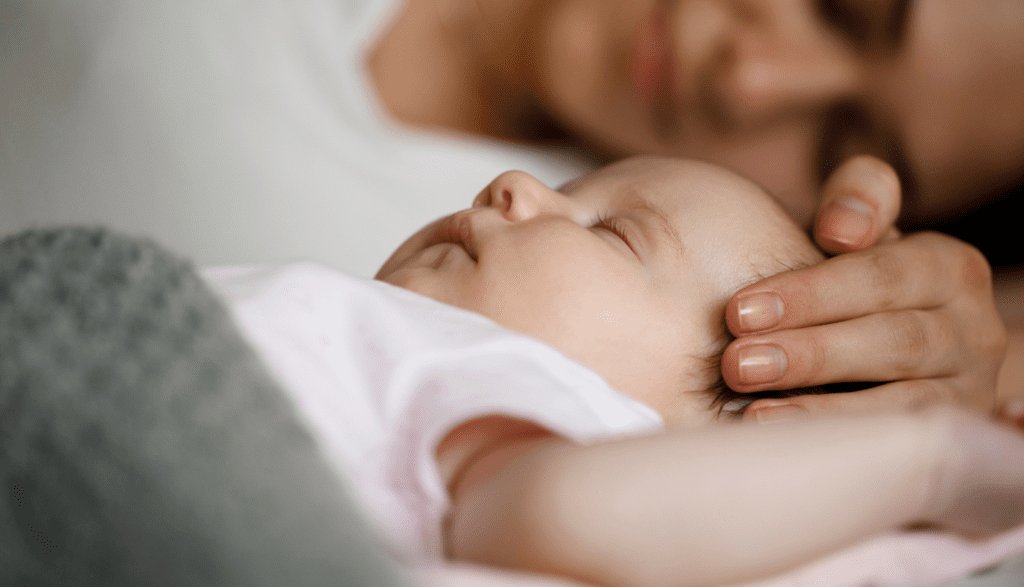Baby Growth Spurt Signs: How to Spot and Soothe Sleep Disruptions
Wondering why your baby suddenly won’t sleep, eats nonstop, and cries more than usual?
It might be a growth spurt. Learn how to recognize the top baby growth spurt signs, what to expect at different ages, and how to soothe your baby (and yourself) through it.
Heads up: This post may include affiliate links. As an Amazon Associate, I earn from qualifying purchases—at no extra cost to you. Full privacy policy and disclosure here.

What Are Baby Growth Spurts?
Growth spurts are rapid periods of physical and developmental changes in babies. During these times, babies may seem hungrier, fussier, or more tired than usual — and their sleep routines often take a hit.
These spurts are completely normal and happen frequently in the first year of life. While they can be exhausting, they’re also a sign that your baby is thriving.
Common Baby Growth Spurt Signs
Recognizing growth spurts can help you respond with confidence instead of panic. Here are the most common baby growth spurt signs to watch for:
1. Increased Hunger and Cluster Feeding
Your baby may want to feed every hour. This is especially true for breastfed babies and typically occurs before a major growth leap.
👉 Tip: Keep snacks and water handy for yourself, especially during evening cluster feeding sessions.
🛒 Affiliate Pick: My Brest Friend Nursing Pillow – Provides crucial support for frequent nursing sessions.
2. Disrupted Sleep Patterns
Sleep becomes unpredictable — longer naps one day, then frequent night wakings the next. Your baby may be cranky due to overtiredness.
👉 Related read: Sleep Advice: Why You Should Never Wake a Sleeping Baby
🛒 Affiliate Pick: Hatch Rest+ Sound Machine – Helps signal sleep during unpredictable patterns.
3. Extra Fussiness and Clinginess
Babies can become especially whiny or clingy. They’re seeking comfort as their bodies and brains adjust.
4. Noticeable Physical Growth
One day their onesies fit — the next, they don’t. You may even notice longer limbs or fuller cheeks overnight.
5. Developmental Leaps
Your baby might start rolling, babbling, or trying to stand — all during or just after a growth spurt.
When Do Baby Growth Spurts Typically Happen?
While every baby is unique, here are the most common growth spurt windows:
| Age | What to Expect |
|---|---|
| 7–10 Days | Baby feeds constantly and may seem unsettled. |
| 3 Weeks | Short naps, cluster feeds, and crying peaks. |
| 6 Weeks | Night wakings increase. You may see sleep regression. |
| 3 Months | Huge developmental leaps. More social but crankier. |
| 6 Months | Appetite surges and potential teething overlap. |
| 9 Months | Crawling starts, and sleep becomes irregular. |
| 12 Months | Physical growth + separation anxiety = sleep chaos. |
💤 Consider tracking patterns with a baby logbook to see recurring growth cycles.
How Long Do Growth Spurts Last?
Most baby growth spurts last 2–3 days, but some may stretch up to a week. Expect the first 48 hours to be the most intense.
How to Handle Baby Growth Spurts Without Losing Your Mind
Here’s how to support your baby — and yourself — through these tricky phases.
💡 Feed On Demand
Yes, it feels endless. But feeding more frequently helps your baby get the calories they need to grow.
Also read: How To Keep Milk Bottles Warm At Night
💤 Respect Sleep Cues
Even if naps are erratic, follow your baby’s sleepy signs. Yawning, rubbing eyes, and zoning out = time for rest.
🛒 Affiliate Pick: Nested Bean Zen Sleep Sack – Gentle weight can help with fussiness during sleep disruptions.
🤗 Offer Extra Comfort
Sometimes your baby just needs cuddles. Babywearing can be a lifesaver during clingy spurts.
🛒 Ergobaby Omni 360 Carrier – Great for soothing cranky babies while staying hands-free.
🎵 Use Calming Tools
Soft lullabies and white noise machines can help reset sleep routines.
👉 Try: 20 Best Lullabies for Kids
🧳 Stay Flexible During Travel
Growth spurts during vacations? Double whammy. Ease up on routines and adjust expectations.
👉 Read: Tips To Get Your Baby To Sleep If You’re On Vacation

Red Flags: When It’s Not Just a Growth Spurt
While baby growth spurt signs are normal, call your pediatrician if:
- Baby has a fever or vomiting
- Refuses to eat for 8+ hours
- Is unusually lethargic
- Shows signs of dehydration (fewer wet diapers)
For peace of mind, see: What You Need To Know About Sudden Infant Death Syndrome
Related Support & Sleep Resources
- Soothing Tips When Baby Wakes Up for Pacifier
- Magic Sleepsuit Reviews: Honest Parent Feedback
- The Baby Sleep Routine That Actually Worked
- Transitioning From Sleep Sack to Blanket Easily
- 9 Ways To Help Protect Your Baby From SIDS
✍️ Final Thoughts: Embrace the Chaos, It’s Temporary
Growth spurts can feel overwhelming, but they’re a sign that your baby is healthy and developing. With a little patience, some helpful tools, and a whole lot of grace, you’ll both get through it.
💬 Have you survived a wild growth spurt lately? Share your experience in the comments!
📌 Pin this post to your baby sleep or parenting board for later!

❓FAQ: Baby Growth Spurt Signs
How do I know if my baby is going through a growth spurt?
Signs include increased hunger, disrupted sleep, fussiness, and noticeable physical changes. These usually last a few days.
Do babies sleep more during growth spurts?
Some do — especially during the recovery phase. Others struggle to settle due to discomfort or overstimulation.
Are growth spurts and sleep regressions the same?
No, but they often overlap. Growth spurts relate to physical growth, while regressions are tied to developmental milestones.
Can a growth spurt cause my baby to cry more?
Yes. Discomfort from growing pains, hunger, and fatigue can lead to increased crying during a spurt.
Should I change my baby’s routine during a growth spurt?
It’s best to follow their lead. Offer flexibility while maintaining comforting anchors like bedtime rituals.
